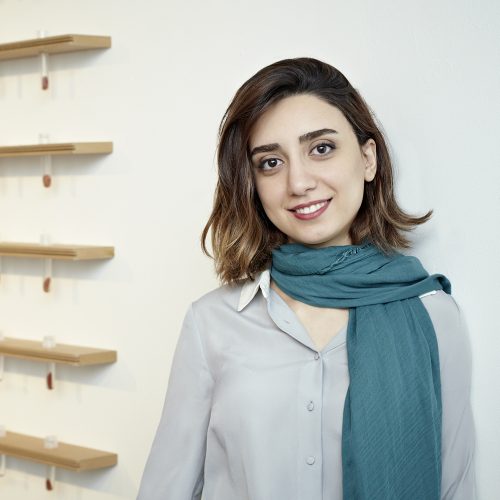Sahar Te Rezazadehtehrani

Sahar Te Rezazadehtehrani
Alumna, Master of Visual Studies
“I meet fascinating MA and PhD students that are working on very exciting topics.”
I graduated from Alberta College of Art and Design in 2017. My artworks are research based, meaning the artwork is the result of a research on certain topics, in my case mostly focused on linguistics, translation, geopolitics, and sociology.
The installation comes from a historical wonder around the existence of the date palm, and geopolitics around it. From the historical places in the Middle East, to deserts of California, the migration of the date palm and oral histories around it are traced and retold. Throughout the installation, I asked the audience to eat dates (a Middle Eastern tradition in funerals), and I transferred their seeds after germination, into the miniature graves in the structure, where they will rest (and grow). To grow date palms in Canada is absurd and playful. They wrestle in decomposition and amnesia beneath the earth. The work questions human centrism in the world of things by amplifying whispers held by seeds.
I knew about the curatorial program at University of Toronto when I was looking for MFA options. I was highly interested in the program because of the instructors and the way the MVS program is formatted. Since my research usually involves multidisciplinary and cross-sectional concepts, the University of Toronto was the perfect place to connect to other departments and get involved with students and faculty from different backgrounds.
I really enjoy the diversity of backgrounds at U of T. You get to meet people who speak different languages, coming from various places, with very interesting focus of research. I get to take my elective courses in different departments and in each course, I meet fascinating MA and PhD students that are working on very exciting topics. The conversations that happen between different practices are very exciting for me. Our program is small and students get a lot of feedback from a diverse group of faulty who are knowledgeable and generous with their feedback.
I spend most of my time in Daniels because I use the woodshop and library. Each of us MVS (studio) students have our own studio space in the North and South Borden buildings, which makes it very convenient to stay on campus for long periods of time to research and make work.
In the summer I got to travel to Iran for both my thesis research and the summer internship, which is a mandatory part of the program. I attended a lot of talks and seminars that related to my research there. It was a very important experience to have, and a great opportunity to visit places that I would not have been able to visit if it was not for academic reasons. Institutions and people in Iran knew about the program and U of T, and helped things move faster because of my limitations with time.
A lot of institutions that I visited and connected with were excited to work with me both as curator and artist. The program has a good reputation within the Canadian arts community and internationally.
Take it seriously, enjoy it, support your peers, and make the most out of it. It is a short time, with lots of different opportunities that are all over the campus. From having very interesting professors and staff members, to your peers, to the talks and seminars on campus, to funds and travel opportunities. Spend a lot of time on the U of T website to find the right opportunities that relate to you.
The campus is very centrally located, convenient for using public transit and biking, lots of food options around, close to great cultural spaces. I really enjoy the library. Throughout my degree at
U of T, I spend most of my time on the online resources of the library. We have so many rare and amazing books at the Fischer and Robarts libraries that an academic person would really enjoy it.
Our proseminars in MVS are also very exciting. We bring well-known and interesting artists, curators, thinkers for talks that are focused on the contemporary art world, and usually students get to have studio visits with the speakers. This is a very good opportunity for students to connect to the art world outside of academia, through an academic context.
